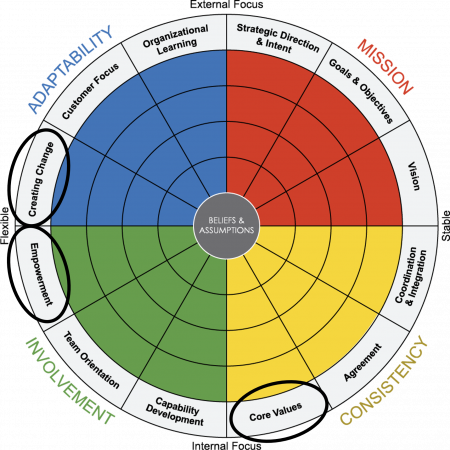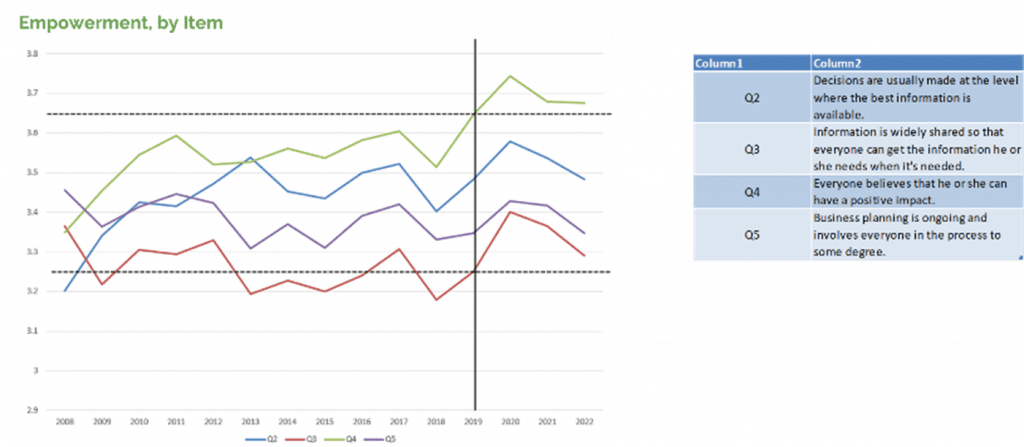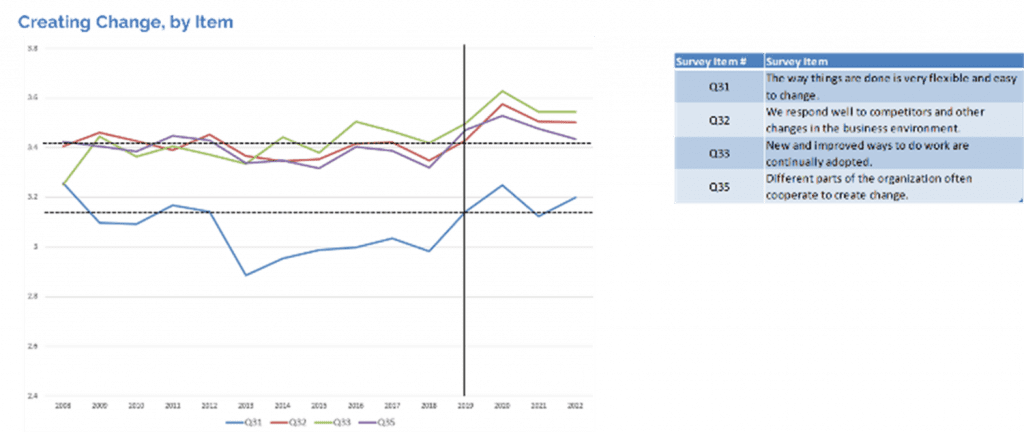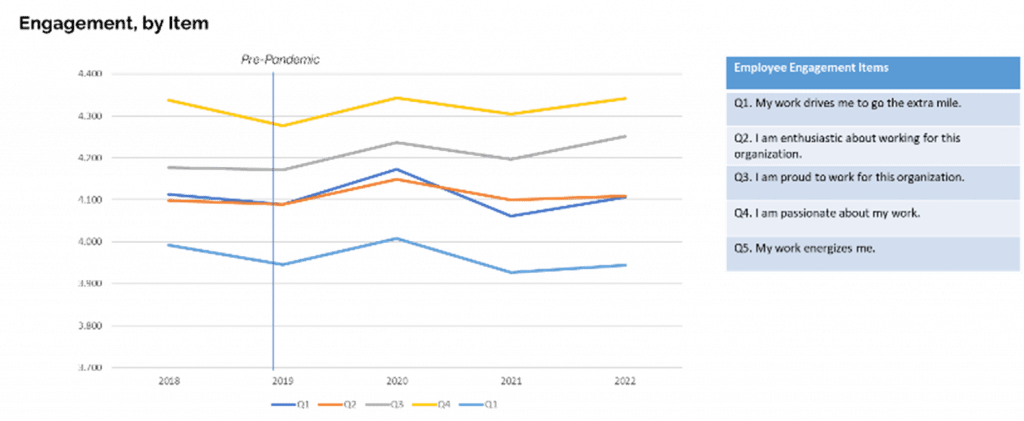Making Sense of Quiet Quitting Pt. 2 – What Does the Data Tell Us?
Dr. Gayatri Pandit, Victoria Lindsay¹, June 2023
Over the Fall of 2022, the term ‘Quiet Quitting’ started buzzing in social media and business publications. Since then, we have heard about ‘Quiet Firing,’ ‘Loud Layoffs’, ‘Quiet Hiring’ and many other buzzy words float about. We at Denison Consulting have given some thought to the emergence of new language to describe organizational norms and behaviors. We present a 2-part paper, first to explore the enduring patterns reflected in Quiet Quitting and the new aspects, and second to share what the data from the Denison benchmark database tells us about Quiet Quitting.
In Part 1: What’s Not New and What’s New, we unpacked Quiet Quitting to understand that employee engagement and citizenship behavior, concepts that have been discussed for quite a while now, are part of Quiet Quitting. We also established that there were some inherent contradictions informing Quiet Quitting, that appear relatively new to organizational discussions. Concepts such as calibrated contributions (with implications for commitment) or organizational silence (with implications for empowerment) are new to the discussion.
In this Part 2, we explore insights from data (based on Denison’s Benchmarking Database including over 1000 organizations) and practices that can help organizations manage those parts of Quiet Quitting that might impact culture.
PART 2: What does the data tell us about Quiet Quitting?
At Denison Consulting, we have worked with more than 10,000 organizations over our 25+ years of studying organizational culture and effectiveness. Based on our model of organizational culture and performance, we assess organizations across four key traits and twelve indices that are linked to various performance metrics. We also examine other performance measures such as Employee Engagement, Commitment, Trust, and Diversity, Equity, and Inclusion (DE&I). We generate a normative benchmark including 1000+ global organizations so that as workplace expectations shift, organizations can see how well they are responding to an increasingly demanding work environment.
To understand the ‘quiet quitting’, we explored our data for trends over the last few years. We used the year 2020 as the reference point for pre and post-pandemic comparisons of patterns that endure and anything that might emerge as new trends.

We looked at two indices of the Denison Culture Model that appear to be connected to quiet quitting based on the insights discussed in Part 1 of this paper: Empowerment and Creating Change. In addition, we looked at our measures for Engagement and Commitment. To be more specific regarding the different connotations of quiet quitting, we found specific survey items within each index/measure to be informative about quiet quitting:

Finding: Organizational Cultures Show Several Enduring Patterns Over The Last Few Years:
- Stronger Organizational Culture and Flexibility
- Positive Impact of Employees on the Organization
- Willingness of Employees to Go the Extra Mile
We found that all culture indicators, including empowerment, engagement, and commitment increased sharply in 2020². Culture scores have dipped since then, but we saw sustained improvement in the indices for Creating Change, Empowerment, and Engagement.

For Creating Change, the question about “The way things are done is flexible and easy to change” has typically seen low scores. After the pandemic, we saw sustained improvement in scores for this item, indicating a perception of greater organizational flexibility. As part of Empowerment, we saw a stronger perception that “Everyone believes that he or she can have a positive impact.”

As an indicator of improved Employee Engagement, we have seen scores start rising in 2022 and in particular, the perception that, “My work drives me to go the extra mile” has stayed strong.

These enduring culture scores tell us that post-Covid, employee engagement is strengthening. We also know that employees are feeling positive about their empowerment and the flexibility they see in the organization. We presume that these culture perceptions are driven by the strong focus by organizations on making the hybrid workplace successful!
Finding: Enduring Relation between Engagement and Mission, Vision, and Adaptability.
To further understand the question, “My work drives me to go the extra mile”, we assessed data from 100+ organizations (150,000+ employees total) that assessed Engagement pre- and post-Covid. We learned that employees who were willing to go the ‘extra mile’ also tended to give the highest importance to the organization’s mission, vision, and goals (high correlation). We also saw that employees who were willing to go the ‘extra mile’ did not find their organizations very flexible or see core values as part of the organizational fabric. These enduring culture indicators tell us that if (as we presume), ‘going the extra mile’ is an indicator of quiet quitting, employees’ tendency for quiet quitting is likely to be weaker if they understand and embrace the organization’s mission. This supports the notion of a strong psychological contract as a deterrent for quiet quitting. We also see the indication that the organization’s ability to adapt to its external environment might be influencing the individual’s willingness to go the extra mile. As we continue on our ‘Quiet Culture’ series, this also emerges as an area for further exploration.

Finding: Engagement and Empowerment Are Not Closely Related Anymore.
We found that post-Covid, employees who are willing to go the ‘extra mile’ for their work do not believe as strongly that everyone can have a positive impact. Nor do they see teamwork as effective or have as strong a sense of empowerment. The changed correlations between different culture questions and the ‘going the extra mile’ question, give us the sense that employees’ perception of how they engage with the organization is changing. While identification with the organization’s mission might still increase employee engagement, the employees’ belief in their own impact or in the benefit of working with others or the value of empowered decision-making may or may not increase their engagement. The hybrid workplace might limit the perceived benefits of teamwork or delegated authority. This changed relationship also indicates a need to further explore psychological safety concerns.

Diminished Employee Commitment
To understand employees’ commitment to their organization, whether as part of emotional attachment or necessity or both, we looked at our data from the ‘Commitment’ (e.g., recommending the organization to others, having a personal connection, preferring to stay with the organization) measure. Looking at Commitment data from 250 organizations and, in particular, data for the question, “I continue to work here more out of choice than necessity,” we have seen a sharp decline in scores in 2022.
With the uncertainty of a recession, and layoffs, the quiet quitting is likely to persist and it is not a surprise to see a decline in commitment. What is a surprise is that we have also been seeing stronger culture scores in general (discussed earlier). We think this contradiction might indicate the changed psychological contract between the employee and the organization. While employees are still engaged in their work and believe in the mission, it is likely that

they – especially the younger generations – do not consider their jobs as much a part of their identity as their predecessors, which might explain the lower commitment. This also might be an effect of the notion of ‘calibrated contribution’, where employees match effort to what they get back. This notion bears further exploration, especially through a comparison of generational differences.
What do we do next?
Quiet quitting as a phrase has been replaced in the media space by other evocative yet fleeting ‘quiet’ phrases (quiet firing, quiet hiring, etc.) that continue to show up. We will continue our work to understand the underlying practical and cultural aspects of these ‘quiet’ phenomena. However, there are some practices that we think will help organizations straddle the changing sentiments and power dynamics between employees and employers:
Emphasize the Manager’s Role
- The manager plays the most important role in translating the organization’s culture and developing trusting relationships in the workplace. Employers should understand their managers’ ability to be effective and develop a trusting workplace. Managers hold the greatest responsibility for articulating and aligning expectations with employees, including calibration of employee ability (and need) to the job and other discretionary requirements.
Understand the Power Dynamics
- The hybrid work environment has also meant a new set of power dynamics. Employees as a collective are in a stronger position to push back on the requirement of onsite presence. Organizations need to employ new performance metrics that are based on job requirements and not on ‘managerial preference in terms of proximity bias. Metrics for tracking discretionary effort in particular will be useful for balancing the changed approaches to collaboration with employee’s choice.
- The younger generations are disrupting how employees influence the organization’s culture. They have entered a dynamic workplace that their older peers are trying to navigate and where the organization’s values might be in flux as it deals with hybrid work. This generation values well-being as part of their basic workplace expectations. While silence might be a fear-based mechanism of older generations, Gen Z in particular are more likely to be silent by preference about how they calibrate their own value to the organization and their perception of the organization’s value for their well-being. Employers need to identify approaches that address this workforce’s needs in a manner that is entirely different from the past.
Essential Changes to Organizational Culture
- Even if (perhaps more so) layoffs are in the future, the organization’s culture should focus on strengthening the core values and in particular developing transparency. Strong core values that are embedded in organizational processes and systems allow employees and managers to frame expectations and challenges in the context of core values. For example, when core values of teamwork, trust, and respect are included in recognition programs and are seen as part of required competencies, employees will be able to see how discretionary efforts that incorporate these values will be recognized by the organization.
- Organizations that are intentional about their culture are more prepared to both respond to and proactively manage emerging organizational phenomena like quiet quitting or, on a larger scale, DEI efforts. We saw that organizations that were able to navigate the pandemic were those that had a strong set of core values, had a clear mission and clarity of purpose, that were able to empower employees to make necessary decisions, and that had the mechanisms in place to quickly adapt to their changing environment.
Address the Tendency to be ‘Quiet’
- As organizations restructure themselves to modernize, accommodate hybrid work, or find success in an AI-enabled world, their ability to adapt (create change, focus on customers, learn collectively) will continue to get stronger. Organizations need to communicate their willingness to allow employees to make decisions and take risks. Agility and innovation are impossible when fear of failure is prevalent. The organization’s emphasis on flexibility and learning is important for psychological safety to be established. This sense of safety is most likely to influence the employee’s preference for ‘going the extra mile’.
Quiet quitting as a buzzword was quickly replaced in the media space by other evocative yet fleeting concepts (quiet firing, quiet hiring, resenteeism, etc.) that continue to evolve. However, a recent Gallup report indicated that Quiet Quitting is indeed persisting. There is always inherent complexity in terms that catch the fancy of the audience. We explored quiet quitting to shine a light on the fact that, although it is considered ‘fuzzy’ and not really a new concept, there are enduring trends that need sustained attention and there are elements that are indeed new and should be understood.
Footnotes:
¹ Contributors: Dr. Bryan Adkins, Jay Richards, Austin Adams
² Denison Webinar: Global Research Trends and Long Lasting Effects of Covid Era






